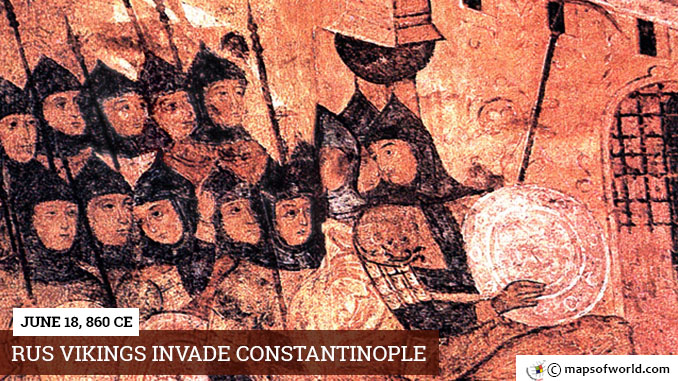Just as the sun set behind the coastal capital of the Greek Orthodox Empire on this day in 860, a flotilla of 200 Viking warships began making landfall in the suburbs of Constantinople. Off-guard and unprotected, the city was only spared thanks to a curious decision by the Rus to turn out into the Sea of Marmara. The history of the event is, in large part, a mystery. Records of an invasion are clear: contemporary sermons from Patriarch Photius of the Greek Orthodox Church are filled with pleas to the congregation for prayers to the Theotokos (Mary, mother of Jesus) on Constantinople’s behalf. Six weeks later, on August 4th, Photius expresses deep gratitude to God for removing the Viking scourge from his homeland. What happened in between has been colored by the development of Greek Orthodox tradition surrounding the event in the centuries that followed. First contact between the Byzantines and the Norse occurred in 839 at the latest, with the two peoples forming a relationship built on trade between opposite ends of the Black Sea. Historians assume business was good for the better part of two decades, as the opportunism demonstrated by the attack – the Byzantine army and navy were away fighting the Arabs – suggests a steady stream of communication. The surprising nature of the attack (“a thunderbolt from heaven”) is without question, with Photius likening the Rus Vikings to “a swarm of bees” as they swept in to the northern suburbs to pillage with ruthless efficiency. With Emperor Michael III away in an attempt to reclaim parts of what is today southeastern Turkey, the citizens could do nothing but capitulate – homes burned brightly in the night as their owners were stabbed or drowned by the invaders. Having terrorized the countryside, the Rus returned to their ships without laying siege to Constantinople proper, instead turning their attention to the Sea of Marmara and the Isles of the Princes. The reasons, though, are unclear. Were they forced to retreat by determined citizens fighting for their lives? Was it part of the plan all along? The answer is not straightforward. Photius’ writings do little to explain what happened, but later works tell of Michael III arriving back in the capital to spread out “the veil of Theotokos.” According to this legend, the Emperor and Photius dipped the relic into the sea. A storm soon erupted, throwing the Rus boats all over the Bosphorus and saving Constantinople. Over time, similar stories appeared, including one in which the veil was walked along the city’s Theodosian Walls, producing the same effect. In the end, the occasion only marks the first of several Rus-Byzantine conflicts – six more would follow over the next two centuries.
June 18 860 CE – Rus Vikings invade Constantinople
Just as the sun set behind the coastal capital of the Greek Orthodox Empire on this day in 860, a flotilla of 200 Viking warships began making landfall in the…
851
